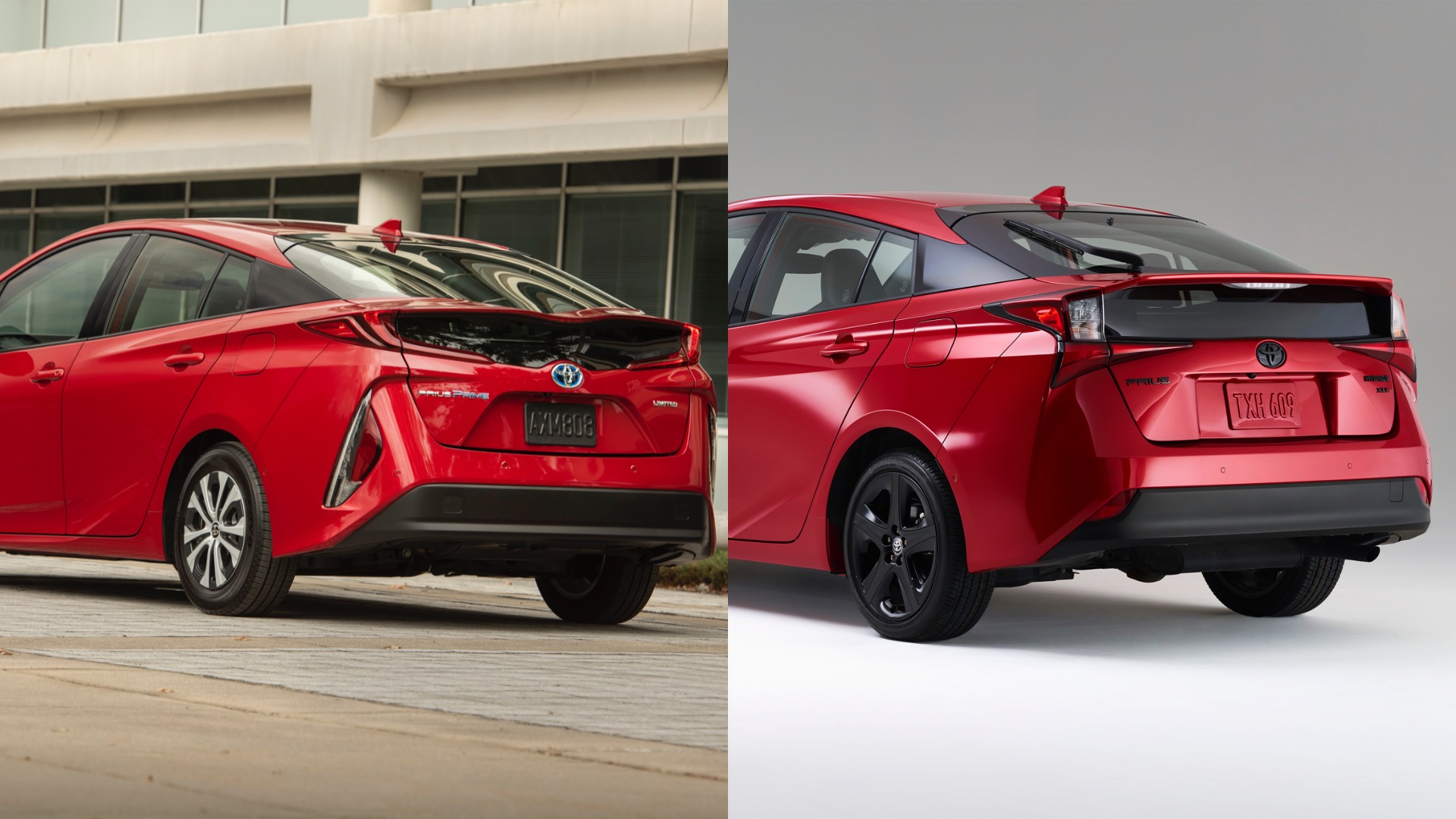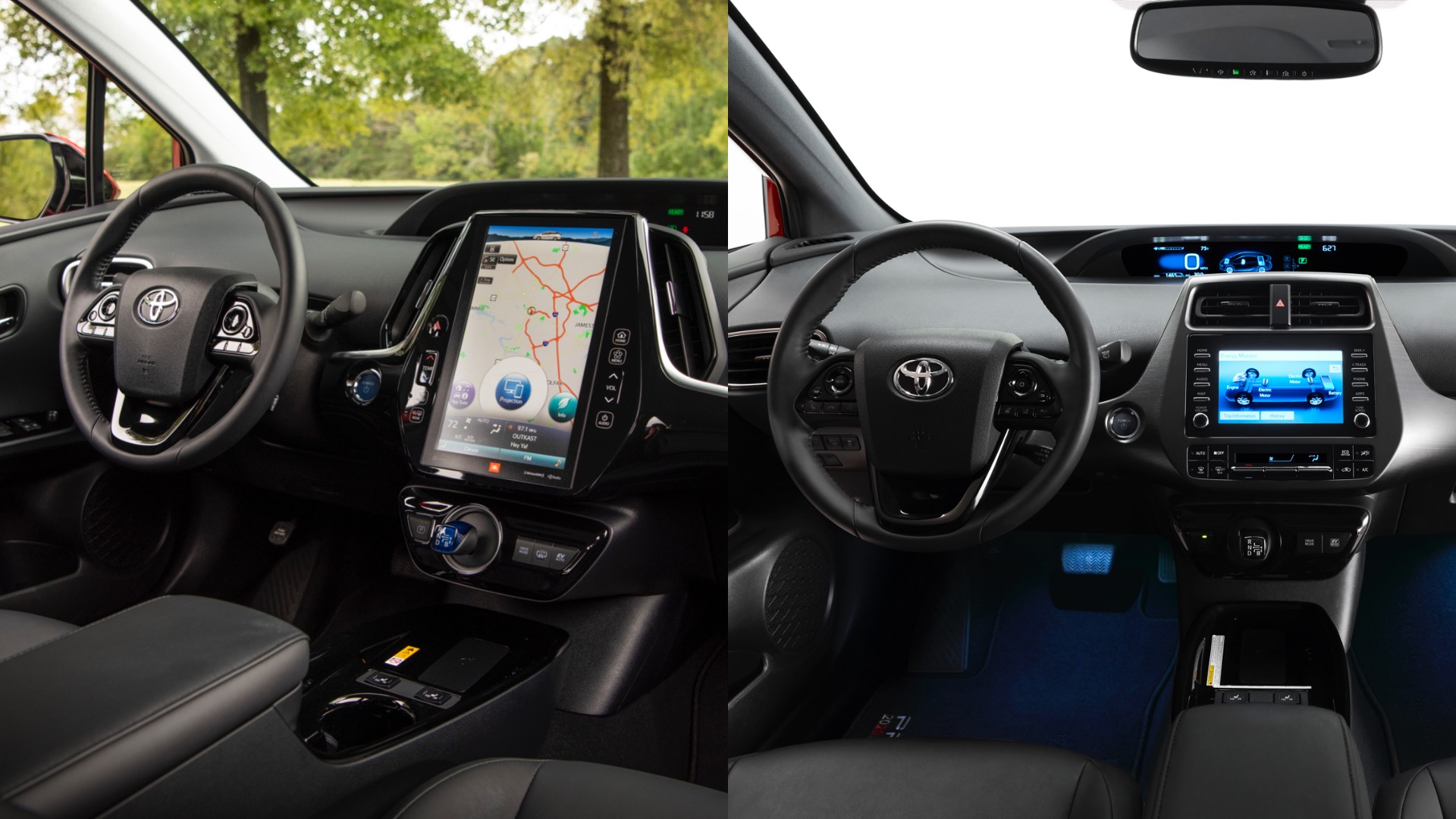With two different flavors of Toyota Prius, having to decide which one to get is a tough decision. Both offer compelling reasons why you should get them as your next daily driver. So, which one should you get? We have a rundown on both vehicles to show you what’s different between each one.
2021 Toyota Prius vs 2021 Toyota Prius Prime exterior

The clearest difference between the Prius and Prime is in the exterior design. Prius Prime models have unique headlights, taillights, and grille that give the car a more conventional look. Despite significant styling revisions, the standard Prius still retains its controversial look, which one can best describe as robotic. Both cars look like wedges, too, to help maximize aerodynamics. The Prius Prime, however, is only available with 15-inch wheels, which are shod in efficiency-minded 195/65R15 tires. Standard Prius variants are offered with 17-inch alloy wheels wearing 215/45R17 tires on the XLE, Limited, and 2020 Special Edition trim.
2021 Toyota Prius vs 2021 Toyota Prius Prime interior
Both the Toyota Prius and Prius Prime offer roomy passenger cabins that fit four people comfortably or five in a pinch. Despite the fast-descending roofline, both vehicles have superb headroom. The long wheelbase and exterior dimensions that are on the big side by compact car standards result in excellent legroom, too. Where things differ is in cargo space. Standard Prius models with 17-inch alloy wheels shod in wider tires have slightly more road noise on the highway.
Regular Prius variants use a small 0.75-kWh lithium-ion or 1.2-kWh nickel-metal-hydride (AWD models) battery that fits under the rear seats. That means you get up to 27.4 cubic feet behind the second row. Folding the 60/40 split-folding rear seats allows the Prius to easily carry bulky. The larger 8.8-kWh lithium-ion battery in the Toyota Prius Prime cuts cargo capacity to 19.8 cubic feet.
2021 Toyota Prius vs 2021 Toyota Prius Prime tech features

An older version of Toyota’s Entune interface is found on the Prius and Prius Prime. Lower trims use a smaller 7.0-inch touch screen with Apple CarPlay and Android Auto compatibility. You’ll find a large 11.6-inch display on the XLE and Limited trims of the Prius Prime and the Limited grade of the standard Prius. The upgraded display, however, loses out on Android Auto. While both the standard upgraded systems are user-friendly, they’re a little slow to respond to your inputs. You can also get an optional 10-speaker JBL audio system that sounds clear but could be better at distributing sound throughout the cabin.
READ: 2021 Toyota Prius review
The Toyota Safety Sense 2.0 driver assistance suite is standard on both the Prius and Prius Prime. On clearly marked roads, the lane-centering feature works well and doesn’t pingpong the car between the dividers. Adaptive cruise control, however, is conservatively calibrated. Even in its closest setting, there’s more than a car length between you and the vehicle ahead, meaning another vehicle can easily cut you off and confuse the system. Other tech features included in the Toyota Safety Sense 2.0 suite include forward collision warning, pedestrian detection, front automatic emergency braking, lane-keeping assist, lane departure warning, automatic high beams, and road sign detection. You can get blind-spot monitoring and rear cross-traffic alert if you choose the LE trim and above on the standard Prius or the range-topping Limited grade of the Prius Prime.
2021 Toyota Prius vs 2021 Toyota Prius Prime driving experience
Although all Prius models use the same 121-hp 1.8-liter I4-based hybrid system, the larger battery in the Prius Prime gives it a more assertive feel when you step on the accelerator. Even though it’s heavier, the Prius Prime moves with more ease than the conventional car. The additional battery capacity also allows the Prius Prime to operate in all-electric mode for longer durations even at highway speeds. The standard Prius, on the other hand, relies on the gas engine more for motivation. At highway speeds, it can coast in EV mode during the right driving situation; however, the moment you put your foot down, it’ll immediately blend power from the gas engine and electric motor to move the vehicle around. You can get AWD on the standard Prius but only on the LE and XLE grades; however, it only works at low speeds.
Thanks to the Prius being underpinned by Toyota’s TNGA-C platform, both Prius models are pleasant to drive. You get a comfortable ride and secure handling in case you need to make emergency maneuvers. XLE, Special Edition, and Limited variants of the conventional Prius add 17-inch wheels and wider tires, which provide a slight handling improvement. Steering in both Prius variants is accurate but isn’t as responsive, hinting at their focus as daily drivers.
2021 Toyota Prius vs 2021 Toyota Prius Prime fuel economy
If you’re buying a Prius in any form, efficiency is extremely important to you. Luckily, every model is supremely miserly on fuel. The base LE Eco model is EPA-rated at 58/53/56 mpg city/highway/combined, putting it near the top. Even the rest of the lineup is efficient with other models earning 54/50/52 mpg for FWD models or 51/47/49 mpg with AWD.
READ: 2021 Toyota Prius Prime review
The Prius Prime is capable of traveling up to 25 miles in EV mode. Should you deplete the battery, charging it to full takes just over two hours using a level 2 charger or around four hours via a regular 110-volt home outlet. EPA fuel economy ratings for the Prius Prime are 55/53/54 mpg, which is right on par with the standard car.
2021 Toyota Prius vs 2021 Toyota Prius Prime pricing
Standard Prius models start at $25,520 for the base LE Eco model. The Rangel topping Limited trim will cost you $33,645. If you’re looking for AWD, they’re only available in the LE and XLE grades, starting at $28,130 and $30,570 respectively. That’s $1,400 more versus an FWD Prius LE and $1,000 pricier than an FWD Prius XLE.
The Prius Prime is more expensive to start at $29,215 for the base LE grade. At the top end, the Limited grade costs $34,995, only $1,350 more than the equivalent conventional Prius. Additionally, the Prius Prime is also eligible for federal and state tax credits or incentives, meaning it’ll cost less if you qualify for it all.
Summary
Get the Toyota Prius if you’re looking for:
- The most cargo space
- Available AWD
- Excellent efficiency but don’t have easy access to a charger or wall outlet
- Slightly better handling on models with wider tires
Get the Toyota Prius Prime if you’re looking for:
- The ability to travel emissions-free for short distances
- A more conventional exterior design
- EV-like driving experience
- Federal and local tax credits and/or rebates

